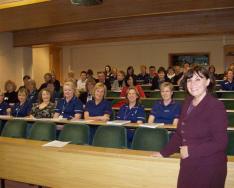AKP
Justice and Development Party
Great Britain, political, Türkiye
Source: http://news.bbc.co.uk/hi/russian/news/ newsid_2397000/2397053.stm
AKP
complete mixed ration
- Social Revolutionaries
Socialist Revolutionary Party
watered
AKP
search- rescue work
PSR
silver solder
AKP
programmable rhythm synthesizer
AKP
pre-design cost of repairs;
pre-design cost of reconstruction
AKP
Production system Rosatom;
Rosatom production system
state, RF
Source: http://www.rosatom.ru/wps/wcm/connect/rosatom/rosatomsite/employee/actualproject/
.
Academician
AKP 2015.
See what “PSR” is in other dictionaries: - AKP Socialist Revolutionary Party AKP Party “A Just Russia” AKP search rescue work (type of sports tourism) AKP silver-based hard solder ... Wikipedia
AKP Threaded drill chuck with marking Example of using PSR 10... Dictionary of abbreviations and abbreviations - drill chuck threaded search rescue rescuing/rescue activities/works full mixed ration... Universal additional practical
AKP Dictionary I. Mostitsky
- Party of Socialist Revolutionaries (RF) party of Socialist Revolutionaries... - AKP Socialist Revolutionary Party AKP Party “A Just Russia” AKP search rescue work (type of sports tourism) AKP silver-based hard solder ... Wikipedia
Dictionary of Russian abbreviations AKP Socialist Revolutionary Party political...
Socialist Revolutionary Party- Leader: Viktor Chernov Date of foundation: 1902 Date of dissolution: 1921 Ideology: Populism International ... Wikipedia
Kamkov, Boris Davidovich
- At the V All-Russian Congress of Soviets. 1918 Boris Davidovich Kamkov (real name Katz; 1885(... Wikipedia Boris Davidovich Kamkov
Boris Kamkov Boris Davidovich Kamkov
- At the V All-Russian Congress of Soviets. 1918 Boris Davidovich Kamkov (real name Katz; 1885, Soroki district of Bessarabia province on August 29, 1938) socialist, leader of Russian socialist revolutionaries, one of the founders of the Left Socialist Revolutionary Party.... ... Wikipedia
- Kamkov, Boris
- Dreams of a new Russia Viktor Chernov 1873-1952, Immonen H.. V. M. Chernov (1873-1952) - one of the founders and leaders of the Socialist Revolutionary Party from 1900 until the early 1920s. He was the main theoretician of the party and consistently...
The Rosatom Production System (RPS) is a culture lean manufacturing and a system of continuous process improvement to ensure competitive advantage at the global level.
The RPS is based on five principles that encourage employees to be attentive to the customer’s requirements (not only in relation to the final consumer, but also to the consumer site, consumer workshop and even the subsequent operator); solve problems where they arise; build quality into the process, do not produce defects; identify and eliminate any losses (excess inventory, interoperational backlogs, downtime, unnecessary movements, etc.); be an example for colleagues.

These principles were formulated on the basis of the best examples of domestic and foreign experience, in particular, the system of scientific organization of labor, production and management (NOTPiU) of the Ministry of Medium Engineering of the USSR and the Toyota Production System of the Japanese automobile company Toyota. The Rosatom production system is aimed at achieving the strategic goals of the State Corporation, and industry RPS projects are aimed at increasing productivity, reducing costs and improving product quality. Knowledge and ability to use RPS tools is prerequisite for professional and career growth of nuclear industry employees.
At the beginning of 2015, it was decided to apply a systematic approach to the deployment of RPS at enterprises: decomposition of goals to the level of the site manager, optimization of the production of the enterprise’s main products (production flows), implementation of RPS projects, training and motivation of employees. By 2017, the system deployment contour grew from 10 to 23 RPS enterprises. By 2020 there will be about 30 of them, their products will form about 80% of Rosatom’s total cost.
According to the concept of development of the Rosatom Production System, all enterprises where the system is being comprehensively deployed are divided into three levels: “PSR Leader”, “PSR Candidate” and “PSR Reserve”. Enterprises - “PSR Leaders” receive a package of privileges (visits of a business coach to the enterprise, the opportunity for employees to travel to exchange experience at foreign and Russian leading enterprises, family vouchers, certificates for training at the Rosatom Corporate Academy, participation in the “Workspace Design” project and etc.).

Currently, the implementation of RPS at industry enterprises has already made it possible to achieve significant savings, reduce inventories in warehouses and reduce the timing of scheduled preventive maintenance at Russian nuclear power plants.
Rosatom Production System (RPS) - a way to manage a production site through control emergency situations by parameters: production plans, safety, quality and workload of operators and equipment.
The main goal of RPS is to identify and reduce all types of losses in production and business processes.
PSR is the successor to the approach of NOTTPiU and the developments of the Ministry of Medium Engineering of the USSR. The RPS includes and adapts to the nuclear industry the best achievements from other modern methodological platforms, primarily the Toyota production system.
The system ensures the implementation of strategic goals through personnel training, as well as through continuous improvement and continuous improvement capabilities to increase productivity, improve quality, reduce costs and meet customer requirements.
According to the concept of development of the Rosatom Production System, all enterprises where the system is being comprehensively deployed are divided into three levels: “PSR Leader”, “PSR Candidate” and “PSR Reserve”. Enterprises - “PSR Leaders” receive a package of privileges (visits of a business coach to the enterprise, the opportunity for employees to travel to exchange experience at foreign and Russian leading enterprises, family vouchers, certificates for training at the Rosatom Corporate Academy, participation in the “Workspace Design” project and etc.).
The introduction of RPS is aimed at embedding the ideas of efficiency and optimality into the logic of adoption management decisions in production, and through production into other processes and structural units companies.
RPS is designed to maximize productive activities per unit of time at each workplace by consistently eliminating losses in production and management processes.
RPS ensures progressive productivity growth production processes, reducing production costs and improving the quality of workers and managerial work. In addition, the RPS is aimed at combating any losses: excess warehouse stocks, inter-operational backlogs, downtime, unnecessary movements.
The development and implementation of the RPS began in the second half of 2008, when general director Sergei Kiriyenko set a goal for the Rosatom State Corporation to increase labor productivity in the industry by four times by 2020, reduce costs and, as a result, reduce the cost of products.
On December 29, 2008, the order “On the implementation of the Rosatom production system in industry organizations” was signed.
Started in 2009 practical work at pilot sites of nuclear power plants under construction and in operation, and in the machine-building complex.
In 2010, 54 projects were successfully implemented through the RPS.
Since August 2011, the second stage of RPS development has been launched, when the system is being implemented in the main production chains of Rosatom enterprises.
At the beginning of 2015, a decision was made to apply a systematic approach to the deployment of RPS. 10 pilot enterprises in the industry were selected, where the implementation of a unified package of RPS measures began (setting goals to the level of small group managers based on the goals of the enterprise, training in the methodology of senior management and project participants, implementation of RPS projects in the office and production using a unified methodology, motivation programs for different levels of employees).
In 2015, seven pilot enterprises met all target indicators for deploying the production system and achieved “Leader” status. These are PJSC KMZ, Balakovo NPP, JSC UEIP, JSC OKBM, Smolensk NPP, FSUE PA Start and PJSC MSZ; they set new ambitious goals and continue to optimize processes.
In March 2016, the selection of Reserve enterprises, applicants for system deployment in 2017, began.
Currently, the implementation of RPS at industry enterprises has already made it possible to achieve significant savings, reduce inventories in warehouses and reduce the timing of scheduled preventive maintenance at Russian nuclear power plants.
Rosatom Production System (RPS)
What is PSR?
The Rosatom production system is a large-scale industry project designed not only to increase labor productivity to the level of foreign competitors of the Rosatom State Corporation and reduce costs, but also to increase wages and create new rules for career growth.
The development and implementation of the RPS began in the second half of 2008, when the General Director of the Rosatom State Corporation Sergei Kiriyenko set the goal of increasing labor productivity in the industry by four times by 2020, reducing costs and, as a result, reducing the cost of products. On December 29, 2008, the order “On the implementation of the Rosatom production system in industry organizations” was signed.
The RPS is based on NOTPiU of the Ministry of Medium Engineering of the USSR - a system of scientific organization of labor, production and management. In addition, the RPS includes and adapts to industry specifics the best achievements and tools from other modern systems, in particular, the principles of the Japanese Toyota Production System.
Japanese 5S principle: Quality - Safety - Productivity
Sort - SEIRI Separate the necessary from the useless
Indicate rarely used
Leave only what you need
Keep order - SEITO Designate a place for each item
Every thing has its place
Keep it clean - SEISO Wash the equipment
Clear workplace
Identify sources of pollution
Eliminate sources of pollution
Standardize - SEIKETSU Indicate places requiring special
attention
Create visual standards
Improve - SHITSUKE Maintain discipline
Follow the 5S rules
Improve standards
BEST PRACTICES AT FSUE "ATOMFLOT":
year 2014:

The project “Increasing the productivity of spent fuel assemblies separation” was implemented within the framework of the enterprise and division of the Nuclear Weapons Complex, the target indicator was achieved - the separation of 5 pieces of spent fuel assemblies in one shift, as well as the ambitious indicator - the separation of 6 pieces of spent fuel assemblies in one work shift.
As part of the optimization of procurement activities, it was put into operation Information system preparation of applications for the purchase of goods/works/services. This project took first place in the category " best project on optimization of office processes (de-bureaucratization).” Author of the work - RHead of the group of new equipment and technology RPSAlexander Melitonov.
2015:
“Optimization of the liquid radioactive waste processing process.” Targets achieved:
The processing time of 90 m 3 of liquid radioactive waste was reduced by 10%;
- labor costs for processing 90 m 3 of liquid radioactive waste were reduced by 60%.
"Optimization of the reloading process nuclear fuel reactors of the OK-900, KLT-40, KLT-40M types using reloading equipment of the 1314 complex.” Targets achieved:
The time spent on reloading nuclear fuel was reduced by 10% (by 4 days).
2016:
- “Implementation of the 5C system at the special section for the repair of ship nuclear power plants and automatic control units (RTK 6 span, western side and 7 span)”, as a result of the implementation of this project, a complete modernization of the repair section for nuclear power plants and automatic control units was carried out. The equipment necessary for repairing special equipment and special fittings was purchased and installed in accordance with the developed layout diagram nuclear icebreakers and ATO vessels. Shelves, workbenches, and cabinets were also purchased and installed. As a result of the project implementation, 100% of workplaces were covered in accordance with the requirements of the 5C system;
- “Use of the CPS SRW container as a recyclable one for loading core casings and cores from reactor plants of nuclear ships,” which allowed saving, preliminary, more than 150,000 rubles;
“Reducing time spent in preparing information and documents for placement in the Unified Information System”, time spent was reduced by 69.8% from 5776 hours to 1746 hours for 572 contracts, which saved more than 1,500,000 rubles.

2017:
Rosatomflot has started training personnel on the RPS course under the guidance of the enterprise’s internal trainer, Alexander Melitonov. The Regulations on motivating employees for the development of Rosatom production are in force.
If you have a proposal aimed at increasing the efficiency of production processes, reducing wasted time, contact the group of new equipment, technology and RPS - group leader Alexander Melitonov tel.: 55-33-01 (ext.: 6269), Leading specialist of the group Valery Romanov tel.: 55-33-01 (ext.: 6168).
For questions about registering for RPS training, please contact the HR department - training and development manager Elena Tkachenko, tel.: 55-33-59 (ext.: 7359).
The implementation of the Rosatom Production System (RPS) is a large-scale industry project designed not only to increase labor productivity to the level of foreign competitors of the Rosatom State Corporation and reduce costs, but also to increase wages and create new rules for career growth.
The RPS is based on NOTPiU of the Ministry of Medium Engineering of the USSR - a system of scientific organization of labor, production and management. In addition, the RPS includes and adapts to industry specifics the best achievements and tools from other modern systems, in particular, the principles of the Toyota Production System of the Japanese automobile company Toyota. The main principle of the RPS, like the Toyota production system, is to meet the needs of the consumer in the shortest possible time with the minimum possible expenditure of resources at the required level of quality.
The purpose of introducing RPS is to create, based on the best examples of domestic and foreign experience, a universal methodology for a management system for complex optimization of production and management processes, and test it at the enterprises of the State Corporation Rosatom. Further development of the RPS will take place in the form software solutions aimed at increasing production efficiency key products, as well as replicating the RPS experience in other sectors of the economy.
The objectives of the RPS are:
- Identification of key Rosatom products and parameters of their competitiveness;
- Setting goals for key products;
- Development of methodological documents on the use of tools for optimizing production processes, diagnosing the production management system and labor resources;
- Optimization of production processes;
- Carrying out comprehensive diagnostics of production for key products in order to identify reserves for increasing production efficiency;
- Approval and launch of comprehensive programs to increase the production efficiency of divisions based on the results of the diagnostics;
- Creation of industry infrastructure to ensure the process of increasing production efficiency.
The system ensures the implementation of strategic goals through personnel training, as well as through continuous improvement and continuous improvement capabilities to increase productivity, improve quality, reduce costs and meet customer requirements. The introduction of RPS is aimed at integrating the ideas of efficiency and optimality into the logic of making management decisions in production, and through production - into other processes and structural divisions of the company.
RPS is designed to maximize productive activities per unit of time at each workplace by consistently eliminating losses in production and management processes. RPS ensures a progressive increase in the productivity of production processes, a reduction in production costs and an increase in the quality of working and managerial work. In addition, the RPS is aimed at combating any losses: excess warehouse stocks, inter-operational backlogs, downtime, unnecessary movements.
The development and implementation of the RPS began in the second half of 2008, when the General Director of the Rosatom State Corporation Sergei Kiriyenko set the goal of increasing labor productivity in the industry by four times by 2020, reducing costs and, as a result, reducing the cost of products. On December 29, 2008, the order “On the implementation of the Rosatom production system in industry organizations” was signed.
Since 2009, the production system has been actively implemented at Rosenergoatom Concern OJSC. It was in the Concern that the first learning programs on RPS tools and the training process has been launched. Moreover, practical work has begun on pilot sites of nuclear power plants under construction and in operation, and in the machine-building complex.
In 2010, 54 projects were successfully implemented through the RPS. At the first stage of implementation, pilot sites were selected at a number of enterprises.
Since August 2011, the second stage of RPS development has been launched, when the system is being implemented in the main production chains of Rosatom enterprises.
Currently, the system is deployed at 79 enterprises in the industry, which are divided into three groups, in order of priority (groups A, B and C). Among the enterprises of group A, the highest priority ones have been identified, which have received the status of reference ones, where promising projects are being carried out, the results of which are planned to be transferred to other enterprises. Many Rosatom enterprises have already achieved certain positive results in implementing the system.
Accounting

